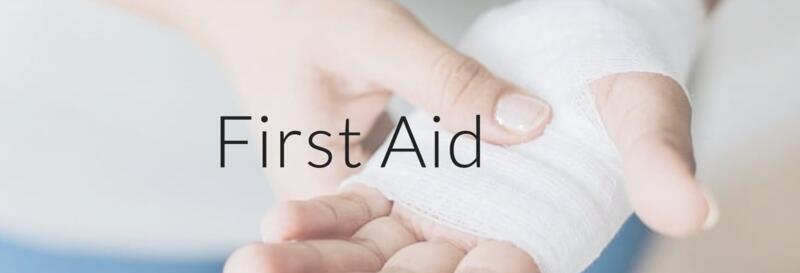
First Aid Information
Contact your local Red Cross or a first aid training facility if you are interested in becoming certified in first aid and CPR. The following information may be helpful to you and your family. It is important to know the basics of first aid.
Always wash your hands before and after treating any injury. Wear gloves when blood or other body fluids are involved.
Nosebleed: Using a tissue, pinch both nostrils closed and apply pressure, tuck head to chest until bleeding stops. Do not pick or blow nose as it will disrupt the clot and bleeding may begin again.
Cuts, scrapes, minor bleeding: For small cuts and scrapes, apply gentle pressure for 20 seconds, clean the area with soap and water, and apply a band aid if needed.
Severe bleeding: Using a clean cloth or bandage, apply pressure and elevate wound. Do not remove bandage to look at the wound. If blood soaks through bandage, apply another layer on top. Continue until no more blood soaks through. Do not remove the bandage as it may disrupt the clot and cause bleeding to begin again. Wrap area with gauze or wrap and seek medical attention.
Sprains/strains: Rest the injured area, apply ice (no more than 20 min at a time), wrap with bandage to support the joint, and elevate.
Burns: For mild burn, run cool water over burned area for 10 -20 minutes. Cover loosely with bandage, and change often.
For a more severe burn, you will see blistering or skin peeling. Remove clothing if over burned areas unless it is stuck to the skin. Run cool water over burned area. Cover loosely with a bandage and seek medical attention.
Heat exhaustion: Remove additional layers of clothing such as jackets. Move person to the shade or a cool room. Give them small sips of cool water. Apply a cool cloth to their forehead.
Broken bones: If you suspect a broken bone, do not attempt to move the injured limb. Apply an ice pack and stabilize the limb in the position you found it with a splint. You can use anything that is hard and firm such as a ruler, stick, thick book or broom handle. Secure in place with strips of fabric above and below the injury area. Elevate and seek medical attention. If a bone is sticking out call 911 immediately and do not move them.
When to call 911:
- Loss of consciousness or not responsive
- Severe bleeding that cannot be controlled
- Difficulty breathing, blue lips or not breathing
- Choking
- Severe head injury
- A fall from a height greater than the person
- Fire or other life threatening situation
Teach your children their address, phone number and how to call 911. They may save the life of someone you care about one day.
This site provides information using PDF, visit this link to download the Adobe Acrobat Reader DC software.
